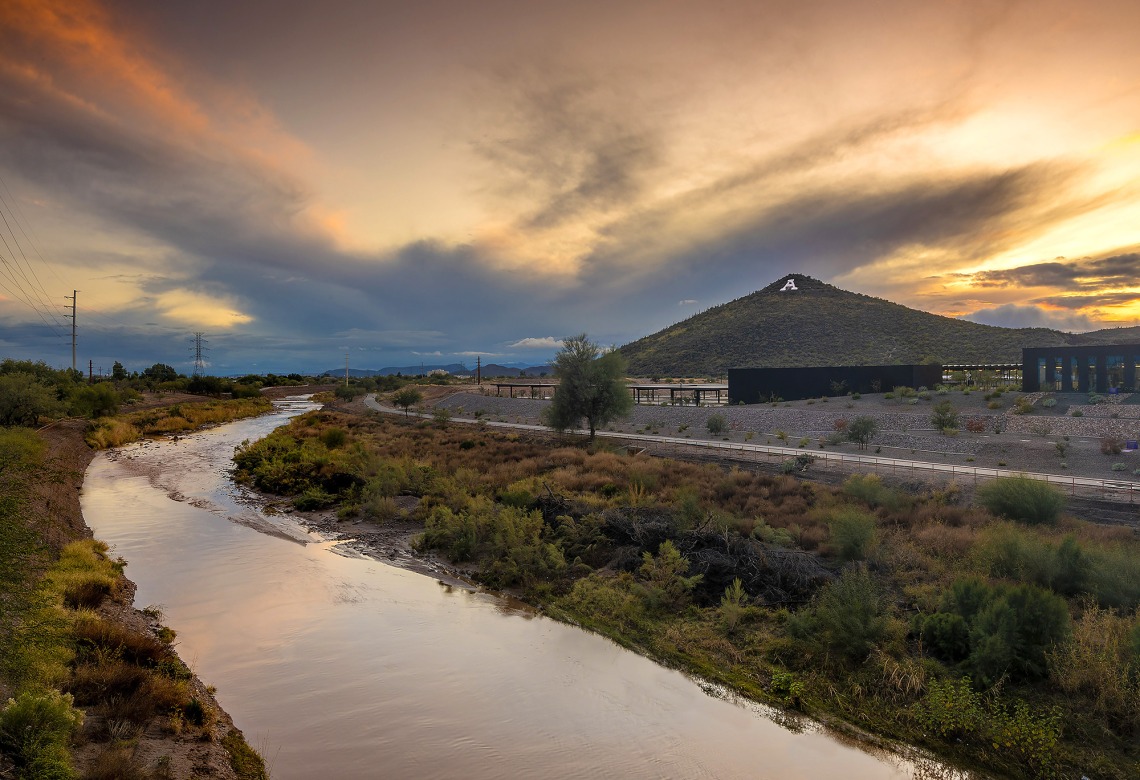Reclaiming a Riverbed

When thinking of the rivers that cut through Tucson, most residents envision a sandy expanse of dry riverbed we call a “wash.” But just south of downtown Tucson, a section of the Santa Cruz River now flows year-round. In the summer, inky black tadpoles blossom in the marshy pools and are stalked by sharp beaked herons and snowy egrets. Vibrantly colored dragonflies zip between lush patches of cattails while panting coyotes quench their thirst. This wild oasis exists alongside the bustle of city life.
On June 24, 2019, Michael Bogan, assistant professor at the University of Arizona’s School of Natural Resources and the Environment, joined several hundred Tucsonans along the dry Santa Cruz River. On this momentous day, reclaimed wastewater flowed for the first time from a release point south of Starr Pass Boulevard out across the parched riverbed. Since its start, the Santa Cruz River Heritage Project has added up to 2.8 million gallons of recycled water to the river daily, making it a perennial source of water in the desert once more.
Amid the celebration and mariachi music that June day, Bogan noticed something significant. “As soon as I got down in the water, just within a few hours of the water being released, I noticed all of these dragonflies that had already flown in and were starting to lay eggs,” he says.
“It was a big wake-up call. The ecosystem was already trying to re-establish itself. This was something that I couldn’t pass up. I had to study it — it’s too interesting.”

Bogan didn’t have funding or personnel for a research project, but he decided to start studying the dragonflies on his own, biking to the river once a month to survey the population. Within four months of the water’s return to the Santa Cruz, Bogan had identified 35 species of dragonfly along the river.
The water’s effect on biodiversity caught Tucson Water’s attention, and a partnership between the university and city government was forged. The unified goal is to recharge the aquifer and maximize the cultural and ecological benefits.
Before 1910, several stretches of the Santa Cruz River had year-round water, flowing through what is now downtown Tucson.
“This section has the longest history of irrigation and use by people anywhere in North America,” says Bogan. “There are irrigation canals coming off the Santa Cruz that are over 4,000 years old. People have been using the river as a source of life for at least that long and probably longer.”
That came to an end around 1913, when the growing city began drawing more water out of the river and its aquifer than could be replenished naturally. By the 1940s, the river had become a dry wash, devoid of its former greenery.
Today, the Heritage Project is restoring the land’s biological and cultural heritage by re-creating the river and its ecosystem.
In partnership with the city, Bogan and his students are working to study and protect the plants and animals that now call the dry riverbed home. Six species of amphibians, 46 species of dragonflies, and over 120 bird species flourish there. In 2020, Bogan’s team successfully reintroduced the Gila topminnow to its former habitat.
“When this project started, I immediately thought about which species that were in the river historically would be the most likely to survive and thrive in this re-creation of the river,” says Bogan. “The Gila topminnow is pretty tolerant of a lot of things, so it was at the top of my list.”
Bogan and team began working with the U.S. Fish and Wildlife Service and Arizona Game and Fish Department to manage endangered species like the topminnow, to relocate approximately 500 minnows from a portion of the Santa Cruz near Nogales to the Heritage Project. The tiny fish is now thriving and is the first of several species Bogan hopes to reintroduce. Others include the Sonoran mud turtle, lowland leopard frog and Mexican garter snake.
“Human-supported places like the Santa Cruz can act as a refuge for a lot of endangered aquatic and riparian species,” Bogan says. “A functioning river ecosystem has a whole bunch of benefits. It supports populations of pollinators. It attracts birds, which attracts birdwatchers to downtown, too.
“And by putting water back in the aquifer, it helps ensure there will be water here for future generations of Tucsonans.”
